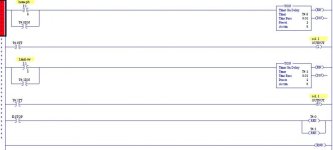As I stated in a previous thread, I'm new at this PLC stuff. Ive been an industrial mechanic-machinist for years and I've been taking a PLC course at a local tech school and lovin it. I would like to use this site as a resource. I hope yall dont mind generic questions. 
I did a small PLC project at school using limit switches and solenoids to act as a clamp and drill. I wanted to put my own twist on it and included a home position pb. I wanted the pb to only work once then become "locked out" until E-stop was pressed. To do this I used a TON set to a few milliseconds with the TT bit turning on a OTL until the cylinder hits its home limit switch which then unlatches. To "lockout" the button, I used the TON's DN bit to hold (seal in) the TON true thus rendering the button useless until the E-stop de-energizes the TON. The instructor said he had never seen the DN bit used that way and didnt recommend it. I realise there are other ways of doing this, but I thought it was kind of clever. Has anyone ever used a timer's DN bit to latch the timer instruction in its DN condition? Or do I need to shut up and move on?
I did a small PLC project at school using limit switches and solenoids to act as a clamp and drill. I wanted to put my own twist on it and included a home position pb. I wanted the pb to only work once then become "locked out" until E-stop was pressed. To do this I used a TON set to a few milliseconds with the TT bit turning on a OTL until the cylinder hits its home limit switch which then unlatches. To "lockout" the button, I used the TON's DN bit to hold (seal in) the TON true thus rendering the button useless until the E-stop de-energizes the TON. The instructor said he had never seen the DN bit used that way and didnt recommend it. I realise there are other ways of doing this, but I thought it was kind of clever. Has anyone ever used a timer's DN bit to latch the timer instruction in its DN condition? Or do I need to shut up and move on?





